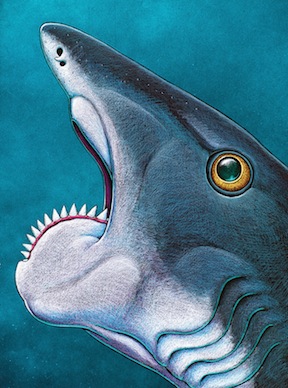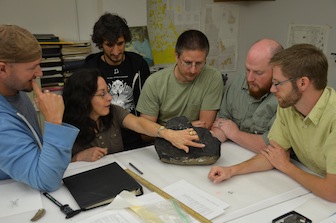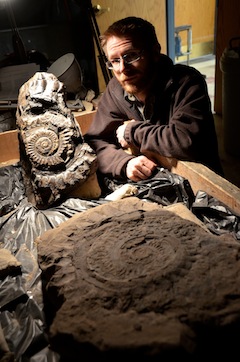Idaho State University researchers solve mysteries of ancient “shark” w/ spiral-toothed jaw; results published in Royal Society’s journal Biology Letters
February 26, 2013
Using CAT scans and making 3-D virtual reconstructions of the jaws of the ancient fish Helicoprion, Idaho State University researchers have solved some of the mysteries surrounding large spiral fossils of this fish's teeth.  The ISU Museum of Natural History has the largest public collection of Helicoprion spiral-teeth fossils in the world. The fossils of this 270-million-year-old fish have long mystified scientists because, for the most part, the only remains of the fish are its teeth because its skeletal system was made of cartilage, which doesn't preserve well. No one could determine how these teeth – that look similar to a spiral saw blade – fit into a prehistoric fish with a poor fossil record, long assumed to be a species of a shark.
The ISU Museum of Natural History has the largest public collection of Helicoprion spiral-teeth fossils in the world. The fossils of this 270-million-year-old fish have long mystified scientists because, for the most part, the only remains of the fish are its teeth because its skeletal system was made of cartilage, which doesn't preserve well. No one could determine how these teeth – that look similar to a spiral saw blade – fit into a prehistoric fish with a poor fossil record, long assumed to be a species of a shark.
"New CT scans of a unique specimen from Idaho show the spiral of teeth within the jaws of the animal, giving new information on what the animal looked like, how it ate," said Leif Tapanila, principal investigator of the study, who is an ISU Associate Professor of Geosciences and Idaho Museum of Natural History division head and research curator.
The results of the study, "Jaws for a spiral tooth-whorl: CT images reveal novel adaptation and phylogeny in fossil Helicoprion," are being published in the Royal Society's journal, Biology Letters. The Royal Society, based in London, England, is a self-governing fellowship of approximately 1,450 of the world's most distinguished scientists, including more than 80 Nobel Laureates.
 In the IMNH's Idaho Virtualization Laboratory Tapanila and his colleagues have virtual reconstructions of the Helicoprion's jaws, based on firm evidence, that clear up the biggest mystery surrounding these teeth.
In the IMNH's Idaho Virtualization Laboratory Tapanila and his colleagues have virtual reconstructions of the Helicoprion's jaws, based on firm evidence, that clear up the biggest mystery surrounding these teeth.
"We were able to answer where the set of teeth fit in the animal," Tapanila said. "They fit in the back of the mouth, right next to the back joint of the jaw. We were able to refute that it might have been located at the front of the jaw."
Located in the back of the jaw, the teeth were "saw-like," with the jaw creating a rolling-back and slicing mechanism. The Helicoprion also likely ate soft-tissued prey such as squid, rather that hunting creatures with hard shells.
Another major find was that this famous fish, presumed to be a shark, is more closely related to ratfish, than sharks. Both of these species are fish with cartilage for a skeletal structure, rather than bone, but they are classified differently.
 "It was always assumed that the Helicoprion was a shark, but it is more closely related to ratfish, a Holocephalan," Tapanila said. "The main thing it has in common with sharks is the structure of its teeth, everything else is Holocephalan."
"It was always assumed that the Helicoprion was a shark, but it is more closely related to ratfish, a Holocephalan," Tapanila said. "The main thing it has in common with sharks is the structure of its teeth, everything else is Holocephalan."
Based on the 3-D virtual reconstruction of the Helicoprian's jaw, the ISU researcher can infer other characteristics about the fish. Using this information, the Idaho Museum of Natural History is creating a full-bodied reconstruction of a modest-sized, 13-foot long Helicoprion, which probably grew as long as 25 feet. This model will be part of the IMNH's new Helicoprion exhibit that will open this summer, which includes artwork by Ray Troll, a well-regarded scientific illustrator as well as a fine arts artist.
The ISU team of researchers on this project included Tapanila, Jesse Pruitt, Alan Pradel, Cheryl D. Wilga, Jason B. Ramsay, Robert Schlader and Dominique Didier. Support for the project, which will include three more scientific studies on different aspects of the Helicoprion, was provided by the National Science Foundation, Idaho Museum of Natural History, American Museum of Natural History, University of Rhode Island and Millersville University.
For more information about the Idaho Virtualization Laboratory, visit vl.imnh.isu.edu.
For more information on the Royal Society, visit royalsociety.org/.
Contact information for Leif Tapanila is 208-282-3871 or
tapaleif@isu.edu.
###

Categories:
